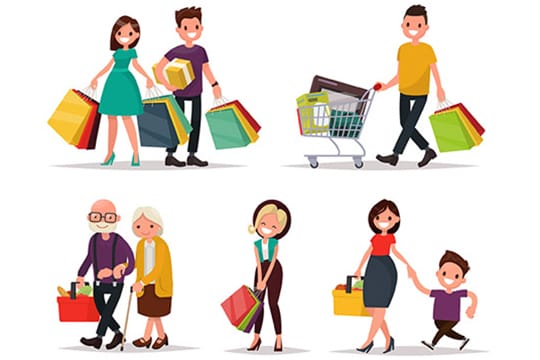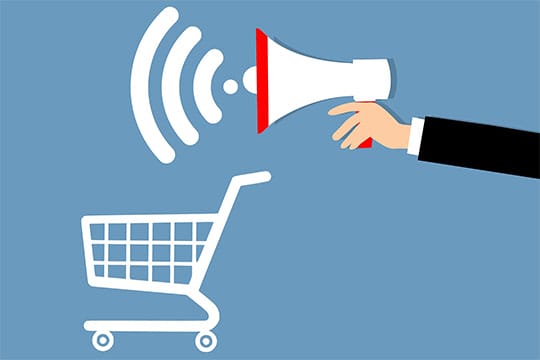The retail sector has branched itself out in all directions in order to cater to the demands of customers. The current group of customers (Gen Z) demands convenience and quick delivery in an organized manner. The fickle minds of these customers coupled with older demographics have led to retail chains developing strategies for omnichannel. Omnichannel refers to the presence of retailers on all available channels such as brick-and-mortar and digital and caters to their needs.
The COVID-19 pandemic has overturned the goals of retail companies with many rushing to create a mark in the digital space. Lockdown restrictions, delays in the supply chain, and preference for cashless transactions had proven to be difficult to manage. However, the presence of content management systems and abundance of skilled technical personnel has led to many retailer’s transitions to e-tailers.
This is exemplified by the random acceleration to digital channels made by Walmart beginning in 2016. The global omnichannel retail commerce platform is expected to reach a value of USD 11.01 billion by 2027, according to a report by Market Research Future (MRFR). Fast delivery times and partnerships with third-party retailers to provide services as well as acquire upcoming brands have sustained the retail chain even during times of the pandemic. However, the generational gap between customers had led to these outlets maintaining a balance between all channels to leverage on all demographics.
Generational Gap

The comfort with technology as well as access to various shops has led to purchasing decisions being made by Gen Z customers. However, older demographics like baby boomers also have a say in the decision owing to being cost-conscious and preference for physical shopping. Here are the few differences in shopping habits between demographics:
Recommended for you: How the Sanitary Crisis of COVID-19 has Changed Remote Access (followed by a Case Study)?
Baby Boomers
Baby boomers have grown up in the era of physical stores and feeling the product before purchase. Although they have embraced technology owing to continuous developments in software and POS terminals, these customers prefer shopping in person as opposed to online channels. But the influence of younger customers within the household has changed the mindsets of the group of customers.
Gen X
Generation X group of customers are comfortable with online shopping but can be persuaded with discounts or bargains. Retailers can leverage the opportunity by pricing products according to their liking and providing slashes prices on bulk volumes of products. Thorough research is one of the biggest habits of the group of consumers; a comparison of prices and product quality will be used in purchasing decisions. Customer service is key to ensuring their loyalty to the brand.
Millennials
Millennials can respond to email and SMS marketing campaigns. The ease of using social media as well as being born during the dot-com era makes them inclined towards such channels. Retailers can create brands to attract them due to their inclination towards trust and trusted influencers. Word-of-mouth marketing, traditional Ads, and digital channels can persuade them in making a decision.
Authenticity and clarity on labeling can be important metrics on which to brand a product targeted towards the group. The use of credit and debit cards is preferred by customers as well as shorter queues. Social media channels are likely to convince the demographic due to their engagement as well as their price-conscious nature. The use of smartphones, desktops, and laptops are being primarily used for their purchasing needs.

Gen Z
The newest demographic requires brands that are attuned with current economic and cultural problems to connect with them. They rely on social media channels and user reviews to make their purchase decisions. The grasp on finances and capability of operating on all portable devices makes them a viable demographic. Moreover, their influence on household purchases as well as their tech-savvy methods of searching for products or items quickly is expected to make them highly lucrative. Product recommendations and loyalty rewards programs will be attractive to them.
The COVID-19 pandemic has changed the shopping habits of consumers and overturned the retail sector. Shortages in supply and distribution chains coupled with delivery restrictions had cut into the profit margins of retailers. But omnichannel did manage to lower the brunt of the effects of the pandemic.
Online Shopping
Online shopping has considerably altered the boundaries of product and customer reach. Prominent retailers and small-time shops have launched their own websites or mobile applications to reach their prospective customers. The pandemic has prevented customers from leaving the comfort of their homes. Retail stores have leveraged customer comfort and convenience to offer products and services at a nominal price and drive sales. For instance, Shoppers Stop, a reputed retail brand in India, has garnered close to 7.5 million downloads of its mobile application. The application can make it easy for adding items to the cart and make payments seamless through a variety of methods.
You may like: 7 Tips to Help Your Business Adapt Following COVID-19.
Launch of New Brands
Many reputed brands such as Xiaomi and OnePlus experimented with online stores to reach out to customers and build their base. They later shifted to offline stores to provide aftermarket and sales services. The pandemic has helped these brands in keeping sales constant and ensuring deliveries from stores within the proximity of their customers’ homes. The omnichannel strategy has strengthened the position of many retailers with a footing in online and offline spaces. Many existing retailers are rebranding their image by launching new products through online channels.

Compliance and Governance
Physical stores require adhering to new stringent standards pertaining to COVID-19 as well as keep their premises sanitized and clean. Changing policies of states within countries require a high level of compliance and governance for ensuring the safety of customers. This can drive huge footfall in shopping malls. Online versions of these stores are attaining huge orders through loyalty programs or discounts. Multi-channels are more lucrative streams compared with single-channel streams as more companies invest in new-age technologies such as near-field communication, location-based services, AI, self-serve kiosks, and chatbots to keep customers engaged.
Rise of Payment Options
The COVID-19 pandemic has stressed the importance of contactless transactions making way for payment modes such as QR codes, mobile wallets, UPI, and others. Mobile shopping has made it convenient for customers across demographics to purchase items without dealing in cash. The launch of new products on social media channels instead of malls has led to high sales owing to the peer pressure of missing out. Moreover, online lending partners have gained steam and garnered interest among banks and non-banking financial corporations (NBFCs). These have given the option of paying through installments or post-delivery.
Free Delivery
Large and small retailers can provide free delivery services by foregoing the delivery period. Heavy investments by these chains to improve the supply and distribution chain of goods coupled with partnering with third-party services have proven to be a deft advantage during the pandemic. Consumer loyalty through different pricing mechanisms and promotions can net them huge profits. The change in customer behavior, as well as management of spending during restricted movement, can be a prime opportunity for retailers to change their marketing strategy.
Perceptional Shift of the Customer during the COVID-19 Pandemic

The consumer journey has shifted from convenience to safety and comfort. Omnichannel makes use of big data and transitions from a physical store to a store on the cloud. The large ecosystem created with the help of platforms, new business models, social networking sites, live streaming sites, influencers, and private traffic will prove to be fruitful to retailers and customers alike.
Products focusing on health and hygiene are likely to take center stage with increasing interest towards immunity-enhancing items. Consumers are purchasing more than the required volume during the pandemic owing to a sudden shift in restriction orders. Brands are changing their attitudes in tune with customers by taking safety measures. Shoppers are also gravitating towards unknown brands with a less physical presence.
Retail chains are offering curbside delivery to make it convenient for shoppers as well as creating multiple touchpoints for enhancing the customer experience. Online shopping experiences may transfer to physical store shopping after the passing of the pandemic. Moreover, the change of communication channels from television to social media can lead to new methods of persuasion and advertising. Key influencers are leveraging on the pandemic for promoting and pushing new products. Offline stores have to craft an online-to-offline (O2O) model for retaining customers. Practical communication methods and resolution of major issues can ensure customer loyalty.
New Measures for Tackling Future Pandemics

Recommended for you: 5 Video Marketing Changes Post-COVID.
Big Data Models
Big data models can be leveraged by customer behavior and used in creating profitable business models. This is evident with customers across demographics willing to forego data for a personalized experience. Big data can be utilized in improving customer experience ranging from customer support to inventory and financials. Cadi, an autonomous golf retailer, leverages big data and omnichannel to provide a seamless shopping experience for seasoned and amateur golfers. It has recently crowdfunded USD 600,000 for expanding its range of kiosks on golf courses globally and aims to capitalize on the recreational sport.
Rapid Deployment of Fulfillment Centers
The change in customer habits by buying in bulk quantities has led to retail chains establishing fulfillment centers to cater to the increasing demand for products. Holiday seasons and concerns for delivery delays are likely to spike its establishment rates. Moreover, the turning off and on of these centers to drive sales can bode well for the omnichannel strategy of retailers. Scaling of eCommerce channels as well as multi-node distribution centers can lead to the stocking of surplus inventory and reduce shipping times. Sudden changes in customer orders can be fulfilled with ease in this manner.
SMEs to Utilize a Blended Approach
Small and medium enterprises (SMEs) are likely to take both approaches – online and offline to tackle future pandemic-like situations. Consumer concerns for safety as well as orderly delivery can be tackled by using same-day delivery routes and slash delivery rates as well. The use of search engine optimization to create a large presence online and gain customer attention may wonder for SMEs. The use of special days to drive sales such as Black Friday and curbside or store delivery can be a potential tailwind for store revenue targets.

Frictionless Digital Experience
Rising customer expectations with regards to digital channels in terms of speed, stability, and delivery duration can push retailers to create a seamless experience. Payment gateways and integration for the latest payment merchants approved by major banks are likely to ease financial transactions and lead to frequent purchases.
High-functioning landing pages and subtle advertising for persuading customers and engaging them through new channels can bode well for the sector. The ability to provide familiar feelings of shopping in-store through personalized interaction, messages, e-mails, and promotional messages can interest customers. Livestreaming is used by retailers for engaging customers and boosting revenue through customized content. Key opinion leaders can help in driving sales through their platforms and engage customers in an entertaining manner.
Focus on Safety
Social distancing guidelines within physical stores after the pandemic passes will take top preference and self-service kiosks for faster payment. Sanitization of surfaces and communication with the masses in a proactive manner will need to be mandatory. In addition, the stress of contactless payment methods and other reforms for trimming operational expenses can gain customer trust. This can be done through a cycle of part-time and full-time employees and a change in operating hours. Apparel and designer stores need to change the design of their stores for tackling new-age customers owing to maximum sales gained through online channels.
You may also like: How Tech & IT Companies Can Manage Cost Efficiently Post-Covid-19?
Final Words

In the end, retail chains need to develop their own omnichannel strategy to cater to their target audience. It can accumulate customer data and leverage it by gaining insights on consumer behavior, shopping time, and convert clients across all channels. User experience will play a major role with considerable investment in the UI of mobile applications and websites. Automation of various processes in the supply and distribution chain coupled with inventory management, account management, and logistics may alleviate various concerns.
This article is written by Ehtesham Peerzade. Ehtesham is a writer and a blogger. He holds a master’s degree in MBA from Pune University and works as a content writer at Market Research Future. He has an avid interest in writing news articles across different verticals. When he is not following updates and trends, he spends his time reading, writing poetry, and playing football. He also possesses an avid interest in world politics and Cricket.
 This article is written by Ehtesham Peerzade. Ehtesham is a writer and a blogger. He holds a master’s degree in MBA from Pune University and works as a content writer at Market Research Future. He has an avid interest in writing news articles across different verticals. When he is not following updates and trends, he spends his time reading, writing poetry, and playing football. He also possesses an avid interest in world politics and Cricket.
This article is written by Ehtesham Peerzade. Ehtesham is a writer and a blogger. He holds a master’s degree in MBA from Pune University and works as a content writer at Market Research Future. He has an avid interest in writing news articles across different verticals. When he is not following updates and trends, he spends his time reading, writing poetry, and playing football. He also possesses an avid interest in world politics and Cricket.




